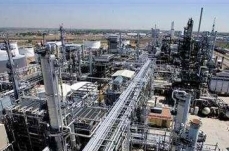Environmental Engineering (main)
From The Encyclopedia of Earth
Environmental Engineering
-
 Featured Article
Featured Article  Fluid catalytic crackingFluid catalytic cracking (FCC) is the most important conversion process used in petroleum refineries. It is widely used to convert the high-boiling hydrocarbon fractions of... More »
Fluid catalytic crackingFluid catalytic cracking (FCC) is the most important conversion process used in petroleum refineries. It is widely used to convert the high-boiling hydrocarbon fractions of... More »
-
 Featured Article
Featured Article  EPA on School SitingThis article, written byBob Weinhold*, appeared first in Environmental Health Perspectives—the peer-reviewed, open access journal of the National Institute of... More »
EPA on School SitingThis article, written byBob Weinhold*, appeared first in Environmental Health Perspectives—the peer-reviewed, open access journal of the National Institute of... More »
-
 Featured Article
Featured Article  Flue gas desulfurizationFlue gas desulfurization is commonly known as FGD and is the technology used for removing sulfur dioxide (SO2) from the exhaust combustion flue gases of power plants that... More »
Flue gas desulfurizationFlue gas desulfurization is commonly known as FGD and is the technology used for removing sulfur dioxide (SO2) from the exhaust combustion flue gases of power plants that... More »
Recently Updated
 Hydroelectricity (Environmental Engineering) Last Updated on 2014-11-30 21:32:21 Hydroelectricity is electricity generated by converting the kinetic energy of falling or flowing water. It is considered the most widely installed form of renewable energy, although most large dams have a finite lifetime unless dredging of silt is periodically conducted. Hydroelectricity has and has a considerably lower output level of the greenhouse gas carbon dioxide than fossil fuel powered energy plants, and less life cycle greenhouse gas impact than solar power. Furthermore, the ecological impacts of hydropower is arguably greater than any form of energy production, due to the large footprint of biological impact of reservoirs and other needed developed areas. Worldwide, an installed capacity of 777 Gigawatts was catalogued in the year 2006, sufficient to supply one fifth of the world power supply. Since most of the prime locations for hydroelectric power have been tapped, the... More »
Hydroelectricity (Environmental Engineering) Last Updated on 2014-11-30 21:32:21 Hydroelectricity is electricity generated by converting the kinetic energy of falling or flowing water. It is considered the most widely installed form of renewable energy, although most large dams have a finite lifetime unless dredging of silt is periodically conducted. Hydroelectricity has and has a considerably lower output level of the greenhouse gas carbon dioxide than fossil fuel powered energy plants, and less life cycle greenhouse gas impact than solar power. Furthermore, the ecological impacts of hydropower is arguably greater than any form of energy production, due to the large footprint of biological impact of reservoirs and other needed developed areas. Worldwide, an installed capacity of 777 Gigawatts was catalogued in the year 2006, sufficient to supply one fifth of the world power supply. Since most of the prime locations for hydroelectric power have been tapped, the... More »  Composting (Environmental Engineering) Last Updated on 2014-06-29 17:28:18 Composting is the controlled biological decomposition and pasteurization of organic materials under aerobic conditions— it involves the action of mesophilic microorganisms followed by thermophilic microorganisms that thrive under increased (more than 50 °C) temperature conditions and if correctly managed, can destroy disease-causing organisms, even weed seeds. Biodegradable organic matter is mineralized while carbon dioxide (CO2), water and heat are liberated, and the residual organic components are stabilized mainly to humic acids. There are various ways of composting—aerobic static piles (non-interventionary), aerobic windrows (interventionary), using worms (vermicomposting, which is in fact a different type of process that does not involve the thermophilic stages), etc. The choice of the method is usually based on the objective. There are many different technologies... More »
Composting (Environmental Engineering) Last Updated on 2014-06-29 17:28:18 Composting is the controlled biological decomposition and pasteurization of organic materials under aerobic conditions— it involves the action of mesophilic microorganisms followed by thermophilic microorganisms that thrive under increased (more than 50 °C) temperature conditions and if correctly managed, can destroy disease-causing organisms, even weed seeds. Biodegradable organic matter is mineralized while carbon dioxide (CO2), water and heat are liberated, and the residual organic components are stabilized mainly to humic acids. There are various ways of composting—aerobic static piles (non-interventionary), aerobic windrows (interventionary), using worms (vermicomposting, which is in fact a different type of process that does not involve the thermophilic stages), etc. The choice of the method is usually based on the objective. There are many different technologies... More »  Vermicompost (Environmental Engineering) Last Updated on 2014-06-19 16:05:40 Vermicomposting, which is composting using worms, can be a faster alternative for organic waste treatment, with the added advantage of better quality fertilizer with nutrients in the slow-release form. Vermicomposting also adds valuable soil microbes into compost and digestive fluids of worms can also be beneficial. Vermicomposting is the breakdown of organic material that, in contrast to microbial composting, involves the joint action of different species of earthworms (not all earthworms are composting worms) and microorganisms and does not involve a thermophilic (i.e., high heat) stage. Because the matrix contains many different organisms, this can be considered as an anthropogenic ecosystem. As the agents of turning, fragmentation and aeration, the worms consume organic wastes such as food waste, animal wastes and sewage sludge to produce a soil conditioner. Vermicomposting may... More »
Vermicompost (Environmental Engineering) Last Updated on 2014-06-19 16:05:40 Vermicomposting, which is composting using worms, can be a faster alternative for organic waste treatment, with the added advantage of better quality fertilizer with nutrients in the slow-release form. Vermicomposting also adds valuable soil microbes into compost and digestive fluids of worms can also be beneficial. Vermicomposting is the breakdown of organic material that, in contrast to microbial composting, involves the joint action of different species of earthworms (not all earthworms are composting worms) and microorganisms and does not involve a thermophilic (i.e., high heat) stage. Because the matrix contains many different organisms, this can be considered as an anthropogenic ecosystem. As the agents of turning, fragmentation and aeration, the worms consume organic wastes such as food waste, animal wastes and sewage sludge to produce a soil conditioner. Vermicomposting may... More »  Concentration expressions and notations Last Updated on 2014-06-18 18:21:06 In chemistry and other sciences, engineering and in fairly common usage, concentration is the measure of how much of a given substance there is in a given mixture of substances. There are many different notations and quantitative expressions of concentration.[1] The most commonly used expressions are discussed below: The mole fraction is a measure of the concentration of a component substance in a mixture of substances. It is defined as the number of moles of a component substance in a mixture divided by the total number of moles of the mixture.[2][3] The mole percent (also referred to as the molar percent) is usually denoted by mole % and is equal to 100 times the mole fraction. The mass fraction is also a measure of the concentration of a component substance in a mixture of substances. It is defined as the mass of a component substance in a mixture divided by the total... More »
Concentration expressions and notations Last Updated on 2014-06-18 18:21:06 In chemistry and other sciences, engineering and in fairly common usage, concentration is the measure of how much of a given substance there is in a given mixture of substances. There are many different notations and quantitative expressions of concentration.[1] The most commonly used expressions are discussed below: The mole fraction is a measure of the concentration of a component substance in a mixture of substances. It is defined as the number of moles of a component substance in a mixture divided by the total number of moles of the mixture.[2][3] The mole percent (also referred to as the molar percent) is usually denoted by mole % and is equal to 100 times the mole fraction. The mass fraction is also a measure of the concentration of a component substance in a mixture of substances. It is defined as the mass of a component substance in a mixture divided by the total... More »  Accidental release source terms Last Updated on 2013-12-18 14:53:28 Accidental release source terms are the mathematical equations that quantify the flow rate at which accidental releases of air pollutants into the ambient environment can occur at industrial facilities such as petroleum refineries, natural gas processing plants, petrochemical and chemical plants, oil and gas transportation pipelines, and many other industrial facilities. Accidental releases in such facilities may occur through acts of nature (e.g., floods, hurricanes or earthquakes), operational errors, faulty design or inadequate maintenance. Governmental regulations in a many countries require that the probability of such accidental releases be analyzed and their quantitative impact upon the environment and human health be determined so that mitigating steps can be planned and implemented. There are a number of mathematical calculation methods for determining the flow rate... More »
Accidental release source terms Last Updated on 2013-12-18 14:53:28 Accidental release source terms are the mathematical equations that quantify the flow rate at which accidental releases of air pollutants into the ambient environment can occur at industrial facilities such as petroleum refineries, natural gas processing plants, petrochemical and chemical plants, oil and gas transportation pipelines, and many other industrial facilities. Accidental releases in such facilities may occur through acts of nature (e.g., floods, hurricanes or earthquakes), operational errors, faulty design or inadequate maintenance. Governmental regulations in a many countries require that the probability of such accidental releases be analyzed and their quantitative impact upon the environment and human health be determined so that mitigating steps can be planned and implemented. There are a number of mathematical calculation methods for determining the flow rate... More »